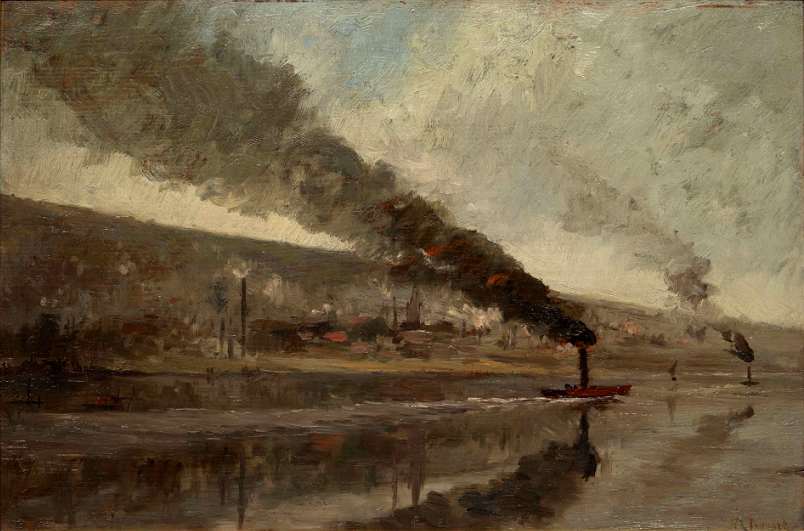The last group of those who showed their work at the First Impressionist Exhibition in 1874, but who have since ‘vanished’, includes a famous sculptor, his son who made stained glass, someone who truly has vanished without trace, and a successful industrialist who was a major patron of the main Impressionists.
Auguste-Louis-Marie Jenks Ottin (1811–1890)
The oldest of the group, Ottin (the father) was born in Paris, and was a pupil of David d’Angers and at the École des Beaux Arts. Although he sketched and painted, he was primarily a sculptor, and was successful in that from as early as 1836, when he won the Grand Prix de Sculpture at the Concours and the Grand Prix de Rome. He made a bust of Ingres in 1840, and numerous works in marble and in bronze.
He acted as the treasurer to the Impressionist group, and showed some of his paintings at the First Impressionist Exhibition in 1874. He does not appear to have maintained any further involvement with them afterwards.

Galatea and Acis found out by Polyphemus the Cyclops (1866) is a statue of his in bronze with marble, forming the Médicis Fountain in the Jardin du Luxembourg, Paris.

His Campaspe taking off her clothes in front of Apelles by order of Alexander (1883) can be seen on the North façade of the Cour Carrée in the Louvre Palace, Paris.

His paintings include Montmartre, Paris (1882).
Léon Auguste Ottin (1836-?)
The son of Auguste-Louis-Marie Jenks Ottin, he was a pupil of his father, Paul Delaroche, and Horace Lecoq de Boisbaudran. His work was shown in the Salons of 1861 and 1862, but he had (probably) three paintings relegated to the Salon des Refusés of 1863. He specialised in stained glass, and his paintings were shown in the First Impressionist Exhibition of 1874, and the second in 1876. His glass was shown in the Universal Exposition of 1878. However his paintings do not appear to have survived.

His work is shown in this detail from the cycle on the life of King Louis XI (date not known), in the Notre-Dame Basilica of Cléry-Saint-André, Loiret, France.
Léopold Robert (dates not known)
Although there was a Swiss painter named Louis Léopold Robert who lived from 1794 to 1835, the exhibition clearly did not show his work. According to the catalogue, this Robert painted in the Barbizon area. I have been unable to find any trace of another artist by this name. He has truly vanished.
Stanislas-Henri Rouart (1833-1912)
He was born into a family of Parisian manufacturers of military uniforms, and was at school with Edgar Degas, who remained his friend. He was a pupil of Léon Cogniet and Édouard Brandon. Although a keen artist, he established a manufacturer of motors for industrial refrigeration plant, then a steel manufacturer. He was influenced by Corot and Millet, whose paintings he collected.
His work was shown in the Salons from 1868-70. During the Franco-Prussian War of 1870, he served with Degas, which strengthened their friendship. He was successful again in the Salon of 1872, but was refused in 1873, showing two paintings in the Salon des Refusés. Degas invited him to take part in the First Impressionist Exhibition the following year, where he showed four paintings and some prints. He was also a friend of Gustave Caillebotte.
Like Caillebotte, he was a patron of the Impressionists, buying their paintings and building one of the notable collections of the day. In 1883, he ended his business involvement so that he could concentrate on painting and collecting. He continued to show his paintings, as many as 26 in the eighth and final Impressionist Exhibition in 1886.
(I apologise for the small size of these images.)

His The Terrace on the Bank of the Seine at Melun (1874) is one of the few paintings of his which has gone into a major museum, that of Musée d’Orsay in Paris, and is thought to have been one of those shown at the First Impressionist Exhibition.

Mountains of Flowers (c 1875) shows his particular love of flowers and gardens, and his gentle painterly style.

Garden (c 1875) appears to be a graphite and watercolour sketch.

Hélène Reading, Rue de Lisbonne (date not known) is one of a series of portraits which he painted of his wife when they lived in Paris, and is looser in its facture than his earlier landscapes.

Walls of a Farm, Queue-en-Brie (c 1880) shows the farmyard of the family’s country property. I am not sure whether its unusual stippled appearance is true to the original, or an artefact of the image.

His Recumbent Nude (c 1880) is also rich in brushstrokes and very painterly.

The Seine near Rouen (1880) is unusual in his work for its depiction of industry, a common theme in other Impressionist landscapes.

Landscape with Bathers (date not known) explores a motif which may have been inspired by Manet, although in a style quite unlike Cézanne’s Bathers series.

In Fontainebleau Forest (date not known) may have been inspired by Corot, but is a realist study in light, shade, and the texture of bark.
Reference
Bona, D (2014) Les Rouarts. De l’Impressionisme au Réalisme Magique, Gallimard. ISBN 978 2 07014 386 3.
In the next and final article in this series, I will draw together the information about these ‘vanished’ Impressionists, and suggest some conclusions.

